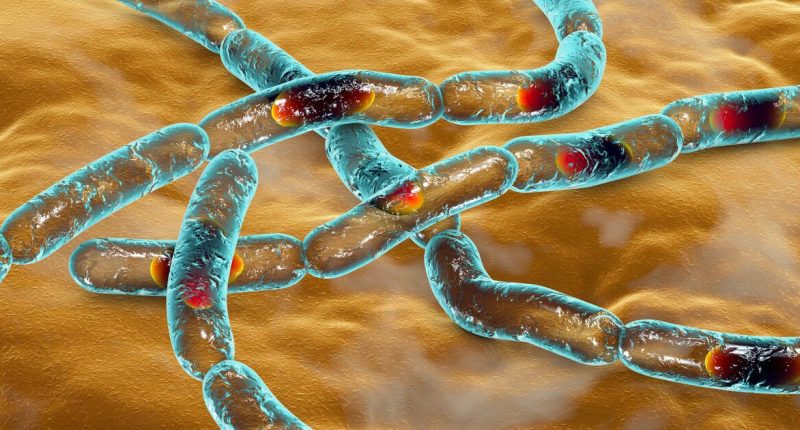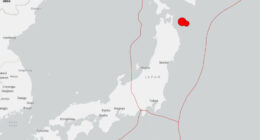Share this @internewscast.com

One person died following complications from catching anthrax (Image: Getty Images)
Fears of an outbreak of a notoriously lethal disease have escalated after Thailand reported four cases of cutaneous anthrax to the World Health Organisation (WHO), marking the country’s first instances in more than three decades. One person died due to complications from the disease, while the other three were hospitalised.
This is the first anthrax-related death in Thailand since 1994. All of the affected had direct contact with cattle believed to be infected with anthrax. In late May, another patient was associated with the slaughtering of cattle.
Don’t miss… Anthrax outbreak sparks cross-border alert in African country near wildlife park

The outbreak was first reported in Thailand before the WHO was alerted (Image: Getty)
Disease control measures, including animal quarantine, a vaccination campaign for cattle within a five-kilometre radius, public awareness initiatives and enhanced surveillance were swiftly implemented in the affected area, officials say.
Anthrax is a potentially deadly disease caused by the spore-forming bacterium Bacillus anthracis, which humans can contract from infected animals or contaminated animal products.
Symptoms vary depending on the type of infection and can appear anywhere from one day to over two months after exposure.
Without appropriate treatment, all forms of anthrax can spread throughout the body, leading to severe illness and even death.

The outbreak was linked to the slaughter of cows (Image: Getty)
Cutaneous anthrax, the most common form, occurs following direct contact with infected animals, carcasses, animal tissues, parts or products, reports the Mirror.
Symptoms of this condition include an itchy, painless papule that develops into a larger blister or vesicle and eventually transforms into a necrotic ulcer with a black, sunken central crust.
Gastrointestinal anthrax, which is contracted by consuming contaminated, undercooked meat, can cause nausea, vomiting, abdominal discomfort, and occasionally diarrhoea.
The confirmed patients range in age from 36 to 58 years old, with three being men and one woman. These cases were identified in the Mukdahan Province, near the border with Laos.

Anthrax is caused by the bacteria Bacillus anthracis (Image: Getty)
World Health Organisation advice
The treatment: The WHO said all human cases of anthrax necessitate hospitalisation. Those potentially exposed to anthrax spores may be given preventative treatment.
It added: “Anthrax responds well to antibiotics, which need to be prescribed by a medical professional. Always follow medical advice on how to take the antibiotics.
“Precisely follow the instructions and do not shorten the course of treatment. Should any side effects of the treatment be noted, please consult a physician at once. Nobody should attempt to use antibiotics or any other drugs to treat or protect themselves without first getting medical advice.”

The WHO recommends immediate hospitalisation for anyone with anthrax (Image: Getty)
The disease: According to the WHO, anthrax is a deadly infection brought on by the spore-forming bacteria Bacillus anthracis. As a zoonotic disease – one that can be passed on from animals to humans – it primarily affects livestock such as cows, sheep and goats.
“The bacteria produce extremely potent toxins which are responsible for the symptoms, causing a high lethality rate. Humans can catch the disease from infected animals or through contaminated animal products,” the WHO said.
The outbreak: The onset of the outbreak has been epidemiologically associated with cow slaughter. The first incident of cattle being butchered occurred in mid-April, leading to meat distribution among local residents.
Subsequent cases surfaced following the slaughter of another cow towards the end of April.
Contact with the meat or during the slaughtering operation is suspected to have caused the infections in all confirmed patients.

Several cases of anthrax were reported in Kabale, Uganda earlier this year (Image: Getty)
Preventive measures saw health checks extended across three villages, flagging two potential cases with symptoms of diarrhoea and fever, yet tests dismissed Bacillus anthracis as the culprit.
Up until May 10, surveillance covered 636 at-risk people. Within this group, 28 had taken part in cattle slaughtering and several other individuals had consumed raw beef.
While anthrax is prevalent in various parts of South East Asia, occurrences of human infection in Thailand are exceedingly unusual.
Several of the country’s public bodies – the Department of Disease Control, the Ministry of Public Health, the Department of Livestock Development and the Ministry of Agriculture and Cooperatives – have put in place measures to curb the spread of the disease.
This includes environmental cleaning and disinfection in 23 high-risk households, pinpointed based on their consumption of potentially tainted meat.
Farmers have been instructed to alert officials about any ill or deceased animals and to refrain from consuming raw meat.
Samples were gathered from knives and chopping boards used by the initial patient, as well as from soil at the slaughter site and beef from the slaughtered cows.
Earlier this year, the North Kivu Province in the Democratic Republic of Congo reported one confirmed and 16 suspected anthrax cases. In addition, seven suspected instances were also logged in the western Kabale district of Uganda.










